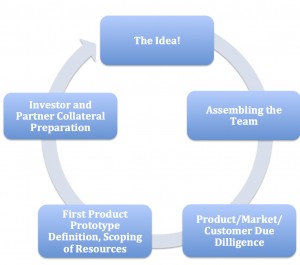You become what you measure. From my experience working with clients across enterprises and startups, the most common reason for failure and inefficiency is the focus on convenient, but inappropriate, metrics. Your technology doesn’t determine the business you build. Neither does your organizational capability. The metric you optimize for is the single biggest factor that determines which business you end up building.
Metric Design
The importance of choosing the right metric is more far-reaching than we often believe. A metric is a bit like a commander’s intent in an army. At battle, there are a lot of variabilities and unexpected contingencies which cannot be pre-planned for. The Commander’s Intent is a simple rule of thumb that helps soldiers take local, individual decisions towards a cohesive, larger goal.
Metrics work in much the same manner. Once you set a metric, the entire team organizes its efforts around it, and works relentlessly to optimize the business for that metric. It’s often fancy to have a large dashboard with multiple graphs tracking hundreds of things. But to be truly effective, an organization/team/individual should be solely focused on optimizing for one metric.
As a result, identifying and designing the right metric is critical for business success. More often than not, I’ve seen the following general observation to hold true:
If you’re asking someone to optimize for more than one metric, you’re setting them up for failure.
Often, ratios help capture multiple movements in one metric. Whether you think of the financial ratios that traditional business managers track or the DAU/MAU that app developers relentlessly track today, ratios tend to be important as they explain concentration rather than quantity.
Pipe Metrics
This discussion of metrics is especially important in the world of platforms and networked businesses. Platform businesses are a lot more complicated than traditional pipe businesses. Pipes optimize unidirectional flow of value. Hence, metaphorically, releasing bottlenecks at any point should help with the flow. The Core Metrics for pipes, naturally, then, measure smoothness of flow and/or removal of bottlenecks. Inventory turnover is one such metric to check how often the flow of goods/services moves through the pipe. All forms of Output/Input ratios for intermediary teams on the Pipe are, again, checks to understand rate of flow and identify creation of bottlenecks.
Platform Metrics
But this tends to be much more complex in the case of platforms where flows are multi-directional. Moreover, they are interdependent because of network effects. E.g. optimizing activity on the producer side may have unexpected implications on the consumer side. On a dating network, allowing over-access to men may be unattractive for women. Hence, even if you have two different teams optimizing for two different metrics on the producer and consumer side, the activities of one team may adversely impact the pursuits of the other team.
How then does one go about deciding on platform metrics?
The Business Of Enabling Interactions
This takes us back to a theme I repeatedly talk about. If I had to condense the essence of Platform Thinking in one line, here’s what it would be:
We are in the business of enabling interactions.
This is much like the Commander’s Intent I mentioned earlier and has important implications. Irrespective of how big your firm is, how complex the operations are, the goal should always be to optimize the core interaction.
1. Identify the Core Interaction that your platform enables
2. Remove all bottlenecks in the Core Interaction to ensure that it gets completed across Creation, Curation and Consumption
3. Ensure that the Core Interaction is repeatable and repeats often
From a metrics perspective, this essentially means that the Core Metric that rules everything should measure interactions.
If you’re running a platform business, you need to start measuring and optimizing your core interaction.
Metrics Design Around The Core Interaction
So we get the fact that we need to measure interactions. However, we still need a measure, a number that shows the Core Interaction is working well. As with all metric design, it is still possible to choose the wrong metric despite understanding the importance of measuring the Core Interaction.
To design the right metric, let’s revisit what the Core Interaction on a platform actually entails.
From earlier essays in this series, we note the following:
1. A platform enables exchange of information, goods/services, money, attention etc. between the producer and consumer. For a visual guide to how this works, check the article here.
2. The exchange of information always occurs on the platform. The other exchanges may or may not occur on it.The exchange of information enables every other exchange to take place. To understand the mechanics of this, refer this article.
3. The exchange of information is the key source of value creation across all platforms and can be visualized as the Core Interaction of the platform. To understand the structure of the Core Interaction in detail, check the article here.
4. The Core Interaction has three parts: Creation, Curation and Consumption of the Core Value Unit
Let’s now look at the different types of platforms and tease out relevant key metrics.
Transaction Capture
Some platforms capture the transaction between producers and consumers. These platforms typically track actual transactions. Platforms like the Amazon marketplace may measure gross value of transactions. Those like Fiverr (which have fixed value per transaction) may simply measure number of transactions. Airbnb tracks number of nights booked. This is a better indicator of value creation than simply tracking number of transactions. At the same time, it doesn’t care about value of transactions (spare mattress being booked vs. castle) as the goal is simply more value created irrespective of type of customer.
Transaction Tracking
Some platforms can track the exchange of goods and services in addition to capturing the exchange of money. ODesk, for example, can track number of hours of work delivered by the freelancer (producer), a key measure of value creation. Clarity.fm can track duration of the consulting call between an expert and the information seeker.
Market Access
Some platforms are unable to capture the transaction, the exchange of money. They create value by allowing producers access to consumers. In these cases, one of the common metrics tracked is the platform’s ability to generate leads. OpenTable specifically tracks reservations. These are not the actual transactions at the dinner table, but serve as a proxy for the value created. Some platforms may track overall/relevant market access. Dating and matrimonial sites often talk about number of women registered as that determines the value that a user can expect to get.
Co-Creation
One of the key properties of platforms is the fact that external producers can add value. Whether it is new apps on an app store, new videos on YouTube or new pictures on Flickr. In these cases, one is tempted to solely track these co-created Value Units. However, Creation forms only one-third of the Core Interaction. The proof of the pudding, in such cases, lies in repeat Consumption. Some platforms may track the total consumption, some may track the percentage of Value Units that cross a minimum threshold of Consumption. I tend to favor the latter as measuring and increasing the percentage of units that get minimum consumption ensures that the platform focuses on getting more producers who create relevant units that will be consumed. It also ensures that, over time, the feedback loops (in the forms of notifications to producers) will encourage creation of the kinds of units that get greater consumption.
Quality as Value
Some platforms may create value largely by signaling quality. Reddit is one such example where Curation is more important than Creation or Consumption. Such platforms may track reputation of users and create feedback loops that encourage users to participate often, gain karma and use that to participate further in the curation process.
Market Attention
Platforms where the Core Value Units are content e.g. YouTube, Medium, Quora etc., the engagement of Consumer Attention serves as a key metric. Measuring number of videos or articles uploaded or number of videos viewed or articles read is often not enough. These give indications of Creation and Consumption but not of Curation. We need some indicator of quality as well. This is why many such platforms track the percentage of content which gets a minimum engagement. Medium tracks views and reads separately indicating that it requires a minimum commitment from the Consumer to determine quality of the content.
The Easy Metric Fallacy
While working with companies on this, I’ve often noted the following:
1. Creation is the most common metric tracked. Number of apps, number of videos, number of sellers etc. This is misleading.
2. In the case of Market Attention category platforms, Consumption is the most common metric tracked. This is an improvement but still not a measure of quality.
3. Curation is rarely tracked and is often the most important metric that determines the health of the platform.
4. The measure of transactions that should be tracked varies with type of platform. In some cases, number of transactions may suffice, in other cases, volume of transactions may matter.
5. The metric that best explains interactions will change over the life cycle of the platform and it’s critical to identify points at which these transitions occur. Companies often make the mistake of sticking on with an older metric when their business has scaled. Identifying and vetting the Core Metric at every point is very important.
Counter Metrics
While measuring the platform’s ability to create interactions is important, it is equally important to measure its failure to close interactions. I will explore this further in a subsequent post.
The Way Forward
The discussion on metrics is deep and cannot be done justice in one post. I’ll cover this more as we move further in the series. The key point, though, remains:
On a platform, the Core Metric that rules them all must measure and optimize the Core Interaction.
Tweetable Takeaways
For platforms, the Core Metric to be tracked must measure and optimize the Core Interaction.Tweet
The goal of a platform is to repeat and optimize the Core Interaction that creates value. Tweet
This article was originally published on Sangeet Paul Choudary’s personal blog Platform Thinking – A blog about building early stage ventures from an idea to a business, and mitigating execution risk.



 In todays exacting times, large corporations like to secure their business continuity on IT products and services sourced from smaller companies, by seeking access to the basic product source code. While the smaller IT companies spend man years developing cutting edge technology solutions, this sharing of the source code could kill their future and business.
In todays exacting times, large corporations like to secure their business continuity on IT products and services sourced from smaller companies, by seeking access to the basic product source code. While the smaller IT companies spend man years developing cutting edge technology solutions, this sharing of the source code could kill their future and business.

 Adopting Lean Startup is no different from any other behavior change that one goes through personally or in an organization. To change behavior and adopt new practice work on several dimensions is required which includes
Adopting Lean Startup is no different from any other behavior change that one goes through personally or in an organization. To change behavior and adopt new practice work on several dimensions is required which includes 

 An example of a company with high IP Score and high company maturity (top right quadrant) is Pfizer. Pfizer has strong patent portfolio of drugs like Lipitor and is a fairly mature and successful company in the Pharmaceutical domain. Pfizer may still end up having overall high need for continued investment in IP Strategy (since the IP relevance of the technology domain is very high) but it is a fairly mature company in its own right.
An example of a company with high IP Score and high company maturity (top right quadrant) is Pfizer. Pfizer has strong patent portfolio of drugs like Lipitor and is a fairly mature and successful company in the Pharmaceutical domain. Pfizer may still end up having overall high need for continued investment in IP Strategy (since the IP relevance of the technology domain is very high) but it is a fairly mature company in its own right.